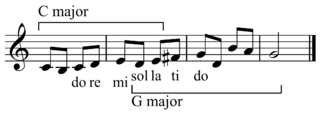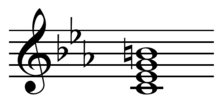
The major scale is one of the most commonly used musical scales, especially in Western music. It is one of the diatonic scales. Like many musical scales, it is made up of seven notes: the eighth duplicates the first at double its frequency so that it is called a higher octave of the same note.
In music theory, a leading-tone is a note or pitch which resolves or "leads" to a note one semitone higher or lower, being a lower and upper leading-tone, respectively. Typically, the leading tone refers to the seventh scale degree of a major scale, a major seventh above the tonic. In the movable do solfège system, the leading-tone is sung as ti.
A seventh chord is a chord consisting of a triad plus a note forming an interval of a seventh above the chord's root. When not otherwise specified, a "seventh chord" usually means a dominant seventh chord: a major triad together with a minor seventh. However, a variety of sevenths may be added to a variety of triads, resulting in many different types of seventh chords.

In music, a chord is a group of two or more notes played simultaneously, typically consisting of a root note, a third, and a fifth. Chords are the building blocks of harmony and form the harmonic foundation of a piece of music. They can be major, minor, diminished, augmented, or extended, depending on the intervals between the notes and their arrangement. Chords provide the harmonic support and coloration that accompany melodies and contribute to the overall sound and mood of a musical composition. For many practical and theoretical purposes, arpeggios and other types of broken chords may also be considered as chords in the right musical context.

In music, modulation is the change from one tonality to another. This may or may not be accompanied by a change in key signature. Modulations articulate or create the structure or form of many pieces, as well as add interest. Treatment of a chord as the tonic for less than a phrase is considered tonicization.
Modulation is the essential part of the art. Without it there is little music, for a piece derives its true beauty not from the large number of fixed modes which it embraces but rather from the subtle fabric of its modulation.
A secondary chord is an analytical label for a specific harmonic device that is prevalent in the tonal idiom of Western music beginning in the common practice period: the use of diatonic functions for tonicization.
In Western musical theory, a cadence is the end of a phrase in which the melody or harmony creates a sense of full or partial resolution, especially in music of the 16th century onwards. A harmonic cadence is a progression of two or more chords that concludes a phrase, section, or piece of music. A rhythmic cadence is a characteristic rhythmic pattern that indicates the end of a phrase. A cadence can be labeled "weak" or "strong" depending on the impression of finality it gives. While cadences are usually classified by specific chord or melodic progressions, the use of such progressions does not necessarily constitute a cadence—there must be a sense of closure, as at the end of a phrase. Harmonic rhythm plays an important part in determining where a cadence occurs. The word "cadence" sometimes slightly shifts its meaning depending on the context; for example, it can be used to refer to the last few notes of a particular phrase, or to just the final chord of that phrase, or to types of chord progressions that are suitable for phrase endings in general.
In music theory, a diminished triad is a triad consisting of two minor thirds above the root. It is a minor triad with a lowered (flattened) fifth. When using chord symbols, it may be indicated by the symbols "dim", "o", "m♭5", or "MI(♭5)". However, in most popular-music chord books, the symbol "dim" and "o" represents a diminished seventh chord, which in some modern jazz books and music theory books is represented by the "dim7" or "o7" symbols.
In music theory, an augmented sixth chord contains the interval of an augmented sixth, usually above its bass tone. This chord has its origins in the Renaissance, was further developed in the Baroque, and became a distinctive part of the musical style of the Classical and Romantic periods.
Chromaticism is a compositional technique interspersing the primary diatonic pitches and chords with other pitches of the chromatic scale. In simple terms, within each octave, diatonic music uses only seven different notes, rather than the twelve available on a standard piano keyboard. Music is chromatic when it uses more than just these seven notes.
In music theory, a dominant seventh chord, or major minor seventh chord, is a seventh chord, composed of a root, major third, perfect fifth, and minor seventh. Thus it is a major triad together with a minor seventh, denoted by the letter name of the chord root and a superscript "7". In most cases, dominant seventh chord are built on the fifth degree of the major scale. An example is the dominant seventh chord built on G, written as G7, having pitches G–B–D–F:
The diminished seventh chord is a four-note chord composed of a root note, together with a minor third, a diminished fifth, and a diminished seventh above the root:. For example, the diminished seventh chord built on B, commonly written as Bo7, has pitches B-D-F-A♭:
In music, a minor seventh chord is a seventh chord composed of a root note, a minor third, a perfect fifth, and a minor seventh. In other words, one could think of it as a minor triad with a minor seventh attached to it.

In music, an augmented sixth is an interval produced by widening a major sixth by a chromatic semitone. For instance, the interval from C to A is a major sixth, nine semitones wide, and both the intervals from C♭ to A, and from C to A♯ are augmented sixths, spanning ten semitones. Being augmented, it is considered a dissonant interval.
The harmonic minor scale is a musical scale derived from the natural minor scale, with the minor seventh degree raised by one semitone to a major seventh, creating an augmented second between the sixth and seventh degrees.
In music theory, the half-diminished seventh chord is a seventh chord composed of a root note, together with a minor third, a diminished fifth, and a minor seventh. For example, the half-diminished seventh chord built on B, commonly written as Bm7(♭5), or Bø7, has pitches B-D-F-A:
In music, an augmented major seventh chord or major seventh sharp five chord is a seventh chord composed of a root, major third, augmented fifth, and major seventh (1, 3, ♯5, 7). It can be viewed as an augmented triad with an additional major seventh. When using popular-music symbols, it is denoted by augM7, +M7, +Δ7, M7♯5, M7(♯5), M7/♯5, M7+5, maj+7, Δ+7, etc. For example, the augmented major seventh chord built on A♭, written as A♭augM7, has pitches A♭-C-E-G:
In music theory, Roman numeral analysis is a type of harmonic analysis in which chords are represented by Roman numerals, which encode the chord's degree and harmonic function within a given musical key.
Musicians use various kinds of chord names and symbols in different contexts to represent musical chords. In most genres of popular music, including jazz, pop, and rock, a chord name and its corresponding symbol typically indicate one or more of the following:
- the root note,
- the chord quality,
- whether the chord is a triad, seventh chord, or an extended chord,
- any altered notes,
- any added tones, and
- the bass note if it is not the root.
The jazz minor scale or ascending melodic minor scale is a derivative of the melodic minor scale, except only the ascending form of the scale is used. As the name implies, it is primarily used in jazz, although it may be found in other types of music as well. It may be derived from the major scale with a minor third, making it a synthetic scale, and features a dominant seventh chord on the fifth degree (V) like the harmonic minor scale. It can also be derived from the diatonic Dorian mode with a major seventh.












